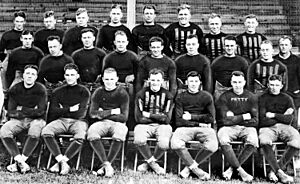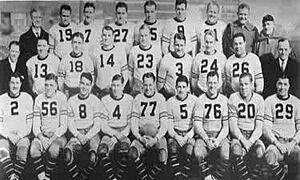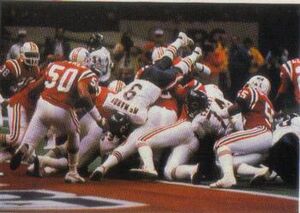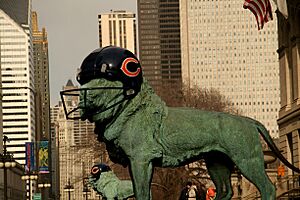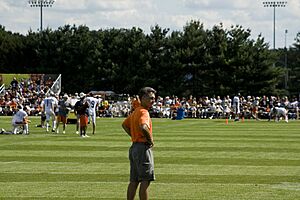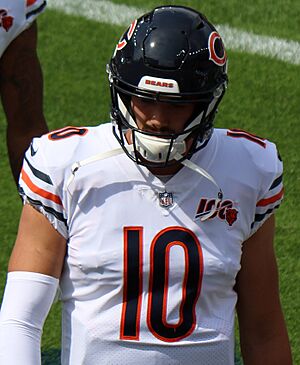History of the Chicago Bears facts for kids
The Chicago Bears are a famous American football team that has been part of the National Football League (NFL) since it began in 1920. They have won nine NFL championships, including one Super Bowl, which is the second-most wins in league history. The Bears also have the most victories of any NFL team (739) and have honored more players by retiring their jersey numbers (14) than any other team. Many Bears players (29) are in the Pro Football Hall of Fame.
Contents
- Early Years: Building a Football Powerhouse (1919–1946)
- Middle Years: Challenges and New Stars (1947–1981)
- The Ditka Era: Bears Rise to Power (1982–1992)
- 1993–2003: The Wannstedt and Jauron Years
- 2004–2012: The Lovie Smith Era
- 2012–2014: New Leadership and Challenges
- 2015–2021: The Ryan Pace Era
- 2021–Present: The Ryan Poles Era
Early Years: Building a Football Powerhouse (1919–1946)
The team that became the Chicago Bears started in 1919 in Decatur, Illinois. It was first known as the Decatur Staleys, a team for workers at the A. E. Staley food company. In 1920, George Halas and Edward "Dutch" Sternaman were hired to manage the team.
On September 17, 1920, team leaders, including George Halas, met to create a new football league. They formed the American Professional Football Association, which later became the National Football League (NFL) in 1922. The Staleys played their first NFL game on October 3, 1920. George Halas is known as the team's founder because he took charge when they joined the NFL.
1920–1921: The Decatur Staleys' First Games
In their first season in the APFA (now NFL), the Staleys won 10 games. They lost the first league championship to the Akron Pros, who finished without any losses. Back then, there wasn't a set schedule, so teams played different numbers of games.
The Staleys had a big rivalry with the Racine Cardinals. Their first game against the Cardinals was a close 7–6 loss for the Staleys. The Staleys finished the 1920 season with a 10–1–2 record overall.
1921–1929: Moving to Chicago and Becoming the Bears
The Staleys were good on the field, but they had money problems. Their home field, Staley Field, was very small, and company employees got discounted tickets.
George Halas worked to make the team better. He replaced most of the company workers on the team with talented college players. After a good start to the 1921 season, the company owner, Gene Staley, offered Halas $5,000 to move the team to Chicago. Halas agreed to keep the "Staleys" name for the rest of the 1921 season. He also made Edward Sternaman his full partner. Halas quickly got a lease at Cubs Park, which later became Wrigley Field. The Chicago Staleys had a great season, finishing 10–1–1 and winning their first league championship.
In 1922, Halas changed the team's name. He thought about calling them the Cubs, like the baseball team that helped them settle in Chicago. But he decided on the Chicago Bears because football players were bigger than baseball players. He thought, "if baseball players are cubs, then football players must be bears!" For several years, the Bears were a top NFL team, but they couldn't win another championship because the league didn't have a playoff system yet.
A big moment in the 1920s was when Halas signed Red Grange, known as "the Galloping Ghost," for a huge amount of money in 1925. At that time, many people thought college football was better than professional football. Halas took the Bears on a 17-game tour across the U.S. to show off Grange. The tour helped make professional football more popular and saved some teams from financial trouble.
Grange left the Bears for a short time but returned in 1929. The Bears ended the decade with a losing season, and Halas stepped down as player-coach, choosing Ralph Jones as the new coach.
1930–1939: NFL Championships and Halas' Return
The Chicago Bears of the 1930s were led by powerful players like Bronko Nagurski and Red Grange. They played in the newly created NFL Championship Game four times and won the league title twice.
In 1932, the Bears and the Portsmouth Spartans tied for first place. They played an "unofficial" championship game indoors at Chicago Stadium. The Bears won 9–0, winning the championship. This game was so popular that the NFL decided to create official divisions and a scheduled Championship Game for the 1933 season.
In 1933, George Halas returned to coach the Bears. He led them to win the first-ever Western Division title and the 1933 NFL Championship Game. The Bears won a very close game against the New York Giants, 23–21. In 1934, the Bears had a perfect 13–0 record, but they lost the Championship Game to the Giants, 30–13. This game became known as the "Sneakers Game."
The Bears played in two more NFL Championship Games that decade but lost both. They ended the 1930s with a losing season in 1939.
In the late 1930s, George Halas and University of Chicago coach Clark Shaughnessy developed a new way to play offense called the T formation. This complex strategy needed a smart and athletic quarterback. Halas recruited Sid Luckman, who became a key player in this new offense.
1940–1946: The "Monsters of the Midway" Dynasty
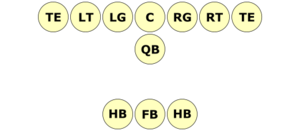
The Chicago Bears from 1940 to 1946 were an amazing team, earning the nickname "Monsters of the Midway". During this time, the Bears played in five NFL Championships and won four of them. Coach George Halas even left the team temporarily to serve in World War II from 1943 to 1945.
In the 1940 NFL Championship Game, Halas introduced the T-formation offense with Sid Luckman as quarterback. This new strategy completely confused the Washington Redskins, and the Bears won 73–0. This is still an NFL record for the biggest win. The T-formation quickly became popular in both college and professional football.
In 1941, the Bears won a playoff game against the Green Bay Packers and then beat the New York Giants 37–9 in the 1941 NFL Championship Game. The Bears started the 1942 season strong before Halas left for the war. Many players also joined the war effort, which caused a shortage of players for the team. The Bears finished the 1942 season with an 11–0 record but lost the Championship Game to the Washington Redskins, preventing them from winning three championships in a row.
In the 1943 NFL Championship Game, the Bears, led by Sid Luckman, easily defeated the Redskins 41–21. Luckman threw five touchdowns in that game.
After a couple of less successful seasons, Halas returned to the team in 1946. Many players also came back from the war. The team regained its strength, finishing the regular season 8–2–1 and winning another Western Division title. The Bears won their last NFL Championship of the decade against the New York Giants, 24–14. This would be the Bears' last championship for 16 years.
Middle Years: Challenges and New Stars (1947–1981)
During these 34 seasons, the Bears had a mixed record. They finished with a winning record or tied record in 17 seasons. They won the NFL Western Division twice and made the playoffs five times. They lost the 1956 Championship but won the 1963 Championship. Even during these challenging years, players like Gale Sayers and Dick Butkus became football legends.
1947–1959: A Decline from the Top
In 1947, the Bears started slowly but then won eight games in a row. However, they lost a key game to their rivals, the Chicago Cardinals, who went on to win the NFL Championship. In 1948, the Bears had another great regular season with a 10–2 record but again lost a crucial game to the Cardinals, missing the division championship.
The Bears continued to be a strong team in 1949 and 1950, but they couldn't reach the Championship Game. In 1950, they lost to the Los Angeles Rams in a playoff game.
The team's performance declined in the early 1950s. In 1952, their defense struggled, and they had their first losing season since 1945. Most of their superstar players from the 1940s had retired by 1953, and the team had back-to-back losing seasons for the first time. A notable event in 1953 was Willie Thrower becoming the NFL's first modern-era African-American quarterback to play for the Bears.
In 1954 and 1955, the Bears had solid 8–4 records, finishing second in their division. After the 1955 season, George Halas stepped down as coach for the third time. He was replaced by Paddy Driscoll. In 1956, Driscoll led the Bears to a 9–2–1 season, winning the Western Division Championship. However, their great season ended with a big loss to the New York Giants in the 1956 NFL Championship.
The Bears' success was short-lived. In 1957, they had a losing record, which led Halas to fire Driscoll and return to coaching himself. In 1958 and 1959, the Bears finished with 8–4 records, but it wasn't enough to win the division. The 1950s were the first decade in Bears history without an NFL Championship.
Halas, always looking for new ideas, found a young assistant coach named George Allen. Allen was very dedicated and introduced new methods like detailed playbooks and thorough research for the NFL draft. With Halas' support, Allen helped the Bears find many future Hall of Fame players through the draft.
1960–1970: Rookie Stars and Another Championship
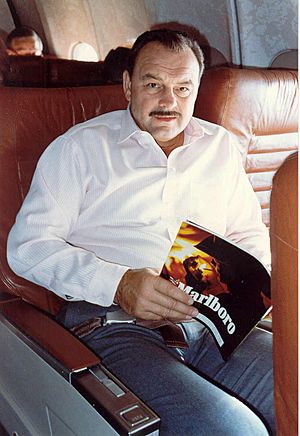
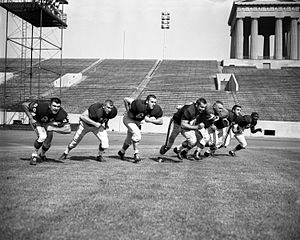
The 1960s began with the Bears as the only NFL team in Chicago. In 1960, they finished with a disappointing 5–6–1 record. In 1961, the Bears improved to 8–6. Rookie tight end Mike Ditka made a huge impact, setting a team record for rookies with 56 catches and winning the NFL Rookie of the Year Award.
The 1962 season saw another rookie star, running back Ronnie Bull, who also won Rookie of the Year. The Bears finished with a strong 9–5 record. The Bears' rookie success reached its peak in 1963. They broke the Green Bay Packers' hold on the Western Division by finishing 11–1–2. In the 1963 NFL Championship Game at Wrigley Field, the Bears defeated the New York Giants 14–10. Quarterback Bill Wade scored both touchdowns, but the real stars were the Bears' defense, who intercepted Giants quarterback Y. A. Tittle five times! This was the Bears' eighth NFL Championship.
The season after their championship, 1964, was disappointing with a 5–9 record. George Halas then drafted two future Hall of Famers: running back Gale Sayers (nicknamed the "Kansas Comet") and linebacker Dick Butkus.
In 1965, Sayers had an incredible rookie year, winning the Rookie of the Year Award and setting a new team record with 22 touchdowns. His amazing season included a six-touchdown performance against the San Francisco 49ers. Sayers continued his success in 1966. Mike Ditka retired at the end of the 1966 season because he was unhappy with Halas. He later became an assistant coach for the Dallas Cowboys.
The year 1967 saw the NFL's first Super Bowl and also the final retirement of George Halas at age 72. He had coached the team for 47 years and had 324 coaching wins, a record that stood until 1993. Halas said he retired because of an old hip injury that made it hard to stand during games.
Jim Dooley took over as coach, and the Bears finished 7–7 in 1968. A sad moment that season was a serious knee injury to Gale Sayers, from which he never fully recovered. After Sayers' injury, his teammate and friend, running back Brian Piccolo, encouraged Sayers to recover. Their friendship was special, especially during a time when race differences were more common in society. Sayers returned in 1969 and rushed for over 1,000 yards, winning the NFL Comeback Player of the Year Award. Despite Sayers' great play, the Bears had their worst season ever, finishing 1–13.
The team faced a tragedy in November 1969 when Brian Piccolo was diagnosed with lung cancer. He passed away on June 16, 1970, at just 26 years old. The Bears created the Brian Piccolo Cancer Research Fund to raise money for cancer research. In 1971, a TV movie called Brian's Song was made about the friendship between Piccolo and Sayers.
1970–1975: Moving to Soldier Field
The 1970s began with a big change for the Bears. After the NFL and AFL merged, the sport became much more popular, and bigger stadiums were needed. Wrigley Field, the Bears' home for nearly 50 years, didn't meet the NFL's new size rules. After their final game at Wrigley Field in December 1970, the Bears moved to Soldier Field in Chicago. They played their first game there on September 19, 1971, winning 17–15 against the Pittsburgh Steelers. However, the Bears finished that season with a 6–8 record, and coach Jim Dooley was fired.
Abe Gibron became the new coach, but the team continued to struggle. In 1973, they finished last in their division with a 3–11 record. Dick Butkus, a legendary player, retired early that season due to knee injuries. The 1974 season was Gibron's last, and the team finished 4–10.
1975–1982: Building for a Championship
George Halas decided to let former Minnesota Vikings general manager Jim Finks rebuild the Bears. In 1975, Finks hired Jack Pardee as coach, which was unusual because he hadn't been a Bears player or assistant coach before. The team finished 4–10, but the best move that year was drafting running back Walter Payton, nicknamed "Sweetness." He would become one of the greatest Bears players ever.
The losing seasons ended in 1976, with Payton rushing for 1,390 yards. The Bears finished 7–7. In 1977, Payton had an amazing year, rushing for a team record of 1,852 yards. He even rushed for 275 yards in one game, a record that stood for two decades. Payton won the NFL Offensive Player of the Year Award and the NFL MVP Award. Led by Payton, the Bears won their last six games to finish 9–5 and make the playoffs as a Wild Card team. However, they lost to the Dallas Cowboys in their first playoff game since 1963.
After the season, Jack Pardee left, and Neill Armstrong became the new coach. The Bears finished 7–9 in 1978. In 1979, the Bears improved and made the playoffs. However, a sad event happened when team president George "Mugs" Halas Jr., son of the founder, passed away. The Bears lost their playoff game to the Philadelphia Eagles.
The Bears didn't return to the playoffs under Armstrong. In 1980, Walter Payton broke Gale Sayers' all-time team record for all-purpose yards. The Bears also had a huge 61–7 win over the Green Bay Packers, their biggest win in that rivalry. Armstrong was fired after the 1981 season.
By the end of the 1970s, the team was building for the future. General manager Jim Finks was creating a championship team. Scout Bill Tobin was great at finding talented players in the draft. And defensive coordinator Buddy Ryan was developing his revolutionary "46 Defense." These pieces were starting to come together for a championship run.
The Ditka Era: Bears Rise to Power (1982–1992)
| "Give me three years, and if you walk with me, we'll go to the dance." |
| ~Mike Ditka's first words to the team |
In 1982, George Halas brought Mike Ditka back to Chicago to be the head coach. Under Ditka, the Bears had a great record of 112–68. He became the second Bears coach to win over 100 games. The Bears won six division titles and played in the NFC Championship three times. The highlight of this era was the 1985 season, when the Bears won Super Bowl XX.
The 1982 season was Ditka's first. He drafted Jim McMahon to be the team's quarterback. The season was shorter due to a player strike, and the Bears didn't make the playoffs. On October 31, 1983, George Halas passed away at 88. He was the last living founder of the NFL. After his death, the initials "GSH" were added to the Bears' uniforms in his honor. His daughter, Virginia Halas McCaskey, and her husband, Ed, took over ownership of the team. In Ditka's second season, the Bears improved to an 8–8 record. The 1983 draft was very important, as it brought in many players who would be key to the 1985 championship team.
In 1984, Walter Payton broke Jim Brown's record for most career rushing yards. Payton's record stood for 18 years. The Bears finished the season 10–6, winning their first NFC Central Division Championship. They beat the Washington Redskins in the playoffs but then lost to the San Francisco 49ers in the NFC Championship.
1985: Super Bowl Champions!
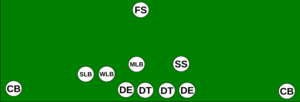
The 1985 is the most famous year in Chicago Bears history. Many people consider the 1985 Bears one of the best NFL teams ever. They won their first 12 games and outscored their opponents by a huge margin.
This season created a lot of excitement around the team. Players like William "The Refrigerator" Perry, Mike Singletary, Jim McMahon, Dan Hampton, and Walter Payton became national stars. The Bears famously beat the San Francisco 49ers 26–10, sacking quarterback Joe Montana seven times. They also beat the Dallas Cowboys 44–0, which was the Cowboys' worst loss ever. The Bears' only loss that season was to the Miami Dolphins, who remained the only team with a perfect season. Around this time, the Bears even filmed a music video called "The Super Bowl Shuffle".
In the playoffs, the Bears shut out the New York Giants 21–0. Then, they shut out the Los Angeles Rams 24–0 in the NFC Championship, advancing to the Super Bowl!
In Super Bowl XX, the Bears were heavily favored to win against the New England Patriots. The game started with a bang when Devin Hester returned the opening kickoff for a touchdown, giving the Bears the fastest lead in Super Bowl history. The Bears then scored the next 44 points, completely dominating the Patriots. They won the game 46–10, capturing their first NFL championship since 1963. Defensive end Richard Dent was named the Super Bowl MVP.
1986–1992: After the Super Bowl
In 1986, the Bears' defense was even stronger, allowing a record-low 187 points. They won another NFC Central title with a 14–2 record. However, their chance to win another Super Bowl was hurt when quarterback Jim McMahon was injured by an illegal hit from a Green Bay Packers player. The Bears then lost to the Washington Redskins in the playoffs.
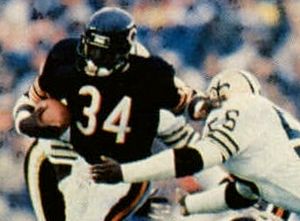
Over time, other teams started to understand and counter the Bears' "46 defense." The Bears also didn't draft enough new players to replace their aging stars.
The 1987 season was affected by a player strike. The Bears drafted quarterback Jim Harbaugh, which caused some tension with Jim McMahon. The Bears still won their fourth straight NFC Central title but lost badly to the San Francisco 49ers. This season was also the end of an era, as Walter Payton retired after 13 seasons. He finished his career with an all-time record of 16,726 rushing yards. In his final playoff game, the Bears lost to the Washington Redskins, with Payton being stopped just short of a first down on a crucial play.
In 1988, the Bears continued to win, earning their fifth straight division title with a 12–4 record. They played the Philadelphia Eagles in a playoff game known as the "Fog Bowl" because thick fog covered the field, making it hard to see. The Bears won 20–12. However, they lost the NFC Championship game to the San Francisco 49ers.
The 1989 season started with Jim McMahon being traded. The Bears finished 6–10 and missed the playoffs.
In 1990, the Bears bounced back to an 11–5 record and won their division. Coach Ditka even coached a game just 10 days after having a heart attack! The Bears won their first playoff game against the New Orleans Saints but then lost to the New York Giants.
The Bears made the playoffs again in 1991 with an 11–5 record but lost to the Dallas Cowboys in the Wild Card round.
The 1992 season was the end of an era. The Bears had their worst record under Ditka, finishing 5–11. As a result, Mike Ditka was fired. Hall of Famer Mike Singletary also retired that season.
1993–2003: The Wannstedt and Jauron Years
For the next 11 seasons, the Bears had a mixed record. They made the playoffs twice and won one playoff game. They only finished first in their division once.
1993–1998: Dave Wannstedt's Time as Coach
In Dave Wannstedt's first season as head coach, the Bears finished 7–9. In 1993, the Bears played their 1,000th game as a franchise, winning 6–0 against the Atlanta Falcons. In 1994, the Bears had a 9–7 season and made the playoffs. They beat the Minnesota Vikings in the Wild Card round but then lost badly to the San Francisco 49ers. In 1995, the Bears again finished 9–7 but missed the playoffs. In 1996, the Bears' record dropped to 7–9.
The Bears continued to decline in 1997, losing their first seven games and finishing 4–12. A highlight was winning their 600th game, becoming the first NFL team to do so. The 1998 season was Wannstedt's last, as the team finished 4–12 again, and he was fired.
1999–2003: Dick Jauron's Time as Coach
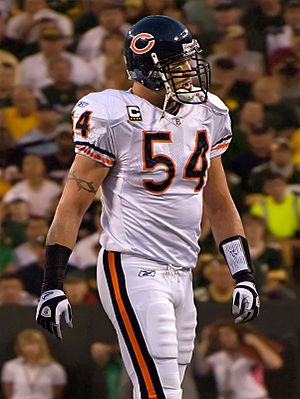
For the 1999 season, the Bears hired Dick Jauron as their new head coach. The team finished 6–10. Sadly, on November 1, 1999, former Bears running back Walter Payton passed away at age 45.
The Bears started the 2000 season poorly, losing their first four games. They finished 5–11, but rookie linebacker Brian Urlacher was named NFL Defensive Rookie of the Year.
The Bears surprised everyone with a great season in 2001. After losing their first game, they won their next six games. Two of these wins were in overtime, thanks to amazing plays by safety Mike Brown, who returned interceptions for touchdowns to win the games. The Bears finished the regular season with a 13–3 record, earning a first-round bye in the playoffs.
In the divisional playoff game, the Philadelphia Eagles defeated the Bears 33–19. Despite the loss, rookie running back Anthony Thomas won the NFL Offensive Rookie of the Year award, and Dick Jauron was named Coach of the Year.
In 2002, Soldier Field was being renovated, so the Bears played their home games at the University of Illinois in Champaign. The NFL also changed its divisions, and the Bears joined the newly formed NFC North. The team struggled with injuries and finished 4–12.

For the 2003 season, the Bears moved back to the newly renovated Soldier Field and introduced their new mascot, Staley Da Bear. However, the team continued to have a mixed performance, finishing 7–9. Quarterback Rex Grossman started the last three games, winning two. Despite this, Dick Jauron was fired. This period after Ditka was marked by many changes at quarterback. The hiring of general manager Jerry Angelo in 2001 brought new hope for the team's future.
2004–2012: The Lovie Smith Era
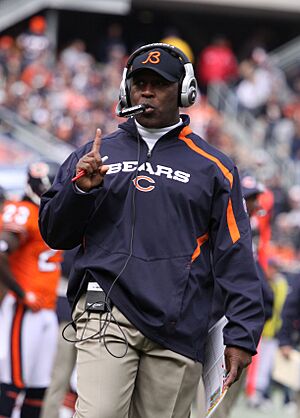
The Bears hired Lovie Smith, a former defensive coordinator, as their new head coach for the 2004 season. Smith had three main goals: beat the Green Bay Packers regularly, win the division, and win the Super Bowl. By the end of 2005, he had achieved the first two goals.
2004–2008: New "Monsters of the Midway" and Super Bowl XLI
In Smith's first year, 2004, the Bears finished 5–11. They struggled with injuries at quarterback, using three different players.
In 2005, rookie quarterback Kyle Orton started the season after Rex Grossman was injured. The Bears started 1–3 but then went on an eight-game winning streak. During this streak, Nathan Vasher returned a missed field goal 108 yards for a touchdown, one of the longest plays in NFL history. The winning streak ended against the Pittsburgh Steelers. The Bears finished the season 11–5, winning the NFC North Division title and earning a first-round bye in the playoffs. Lovie Smith was named NFL Coach of the Year.
In the playoffs, the Carolina Panthers defeated the Bears 29–21.
The Bears started the 2006 season by winning their first seven games, their best start since 1988. Quarterback Rex Grossman, now healthy, played well. The Bears' defense was also very strong. They had a famous comeback win against the Arizona Cardinals, overcoming a 20-point deficit. Devin Hester also tied Nathan Vasher's record for the longest missed-field goal return. The Bears clinched their second straight NFC North title and a playoff spot.
Despite some ups and downs from Grossman, Lovie Smith kept him as the starting quarterback. The Bears defeated the Seattle Seahawks 27–24 in overtime in their first playoff game.
The following week, the Bears faced the New Orleans Saints in the NFC Championship. The Bears' defense shut down the Saints' offense, and their running backs gained nearly 180 yards. The Bears won 39–14, earning the George Halas Trophy and a trip to Super Bowl XLI against the Indianapolis Colts. Lovie Smith became the first African-American coach to lead his team to a Super Bowl.
The Bears were considered underdogs in Super Bowl XLI. Devin Hester started the game with an amazing kickoff return for a touchdown, giving the Bears the quickest lead in Super Bowl history. However, the Colts came back and defeated the Bears 29–17.
Success didn't continue in 2007, as the Bears struggled and finished 7–9. Lovie Smith benched Grossman for Brian Griese, but injuries hurt the team.
In 2008, Lovie Smith named Kyle Orton the starting quarterback. Rookie running back Matt Forte had a great season, rushing for over 1,200 yards. The Bears finished with a winning record of 9–7 but missed the playoffs by one game.
Jay Cutler Trade and Later Years
In 2009, the Bears traded Kyle Orton to the Broncos for quarterback Jay Cutler. The 2009 season started with Cutler throwing four interceptions in a loss to the Green Bay Packers. The Bears bounced back to a 3–1 record, including a win over the Super Bowl champion Pittsburgh Steelers. However, they then lost eight of their next ten games, finishing 7–9.
In 2010, the Bears signed Pro Bowler Julius Peppers. They started the season 3–0, but then Jay Cutler suffered a concussion. The team struggled with injuries and offensive line issues. After their bye week, offensive coordinator Mike Martz changed the offense. The Bears then won several games, including a 16–0 shutout of the Miami Dolphins, which was the Bears' 700th win, a league first.
The Bears finished the 2010 regular season with an 11–5 record, earning the number-two seed in the NFC playoffs and a first-round bye. In the divisional round, the Bears defeated the Seattle Seahawks 35–24, advancing to the NFC Championship.
The Bears faced their rivals, the Green Bay Packers, in the NFC Championship. The Packers took an early lead. Jay Cutler left the game with a knee injury and was replaced by backup quarterbacks. The Packers won 21–14 and went on to win the Super Bowl. Cutler received a lot of criticism for leaving the game, but he was defended by the Bears and other players.
In 2011, the Bears were 7–3 with Cutler, but he suffered a thumb injury. The team then lost five straight games, and running back Matt Forté also got injured. The Bears finished 8–8.
2012–2014: New Leadership and Challenges
In 2012, general manager Jerry Angelo was fired. Phil Emery was hired as the new general manager. Emery's first big moves were signing Matt Forté and trading for Pro Bowl receiver Brandon Marshall, reuniting him with Jay Cutler.
The Bears started the 2012 season strong, becoming the first team to return six interceptions for touchdowns in the first seven games. However, they missed the playoffs after starting 7–1. As a result, Lovie Smith was fired. He was replaced by Marc Trestman, who had coached in the Canadian Football League. On March 20, 2013, legendary linebacker Brian Urlacher left the Bears after they couldn't agree on a new contract.
The Trestman era began with a win. In his first season, 2013, Trestman helped the Bears have one of their best offenses in team history, scoring many points and setting team records for total yards and passing yards. However, the defense had one of its worst years, allowing many yards and points. The Bears finished 8–8 and missed the playoffs after losing to the Green Bay Packers in the final game.
In 2014, the Bears struggled and finished 5–11. Trestman and Emery were both fired at the end of the season.
2015–2021: The Ryan Pace Era
On January 8, 2015, the Bears hired Ryan Pace as their new general manager. A week later, they hired John Fox as their new head coach. In Fox's first season, 2015, the Bears improved to a 6–10 record, including a Thanksgiving Day win over the Packers.
In 2016, the Bears were hurt by many injuries, especially at quarterback. They finished with a 3–13 record, their worst since the NFL expanded to a 16-game schedule. None of the three quarterbacks who played that season returned for 2017.
In the 2017 NFL draft, the Bears selected quarterback Mitchell Trubisky. He became the starting quarterback after the first four games. The Bears finished 5–11. On January 1, 2018, John Fox was fired. A week later, Matt Nagy was hired as the new head coach.
On September 2, 2018, the Bears made a big trade, acquiring star defensive player Khalil Mack. In the 2018 season, the Bears returned to the playoffs for the first time since 2010, winning the NFC North division. However, their season ended in the Wild Card round with a loss to the Philadelphia Eagles after a game-winning field goal attempt hit the goal post twice and missed.
The 2019 season began with high hopes, but the Bears finished 8–8 and missed the playoffs. Their defense was strong, but their offense struggled.
Before the 2020 NFL season, the Bears traded for veteran quarterback Nick Foles. Coach Nagy named Trubisky the starter to begin the season. The Bears started 2–0, but Trubisky was benched in Week 3. Foles led a comeback win. The Bears reached a 5–1 record with Foles, but then suffered six straight losses. Trubisky reclaimed his starting role after Foles was injured. The Bears won their next three games. They finished the season 8–8 and made the playoffs as a wildcard team. They lost to the New Orleans Saints in the Wild Card round.
Nagy and Pace remained for the 2021 NFL season. The team signed veteran quarterback Andy Dalton and drafted Justin Fields. Dalton was injured early, and Fields became the starting quarterback. Fields' first start was a tough loss where he was sacked nine times. The Bears had a five-game losing streak and finished 6–11. Both Matt Nagy and general manager Ryan Pace were fired after the season.
2021–Present: The Ryan Poles Era
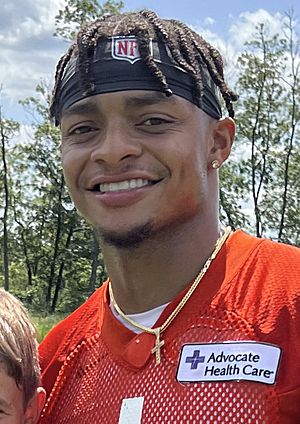
The Bears hired Ryan Poles as their new general manager and Matt Eberflus as their head coach. Luke Getsy was hired as offensive coordinator to help develop Justin Fields. The team also traded star linebacker Khalil Mack to get more draft picks. They also let go of several other veteran players.
The team started the 2022 season 2–1, but then struggled. They traded defensive stars Roquan Smith and Robert Quinn for more draft picks. The Bears then had a franchise-record 10-game losing streak. Despite the team's struggles, Justin Fields set several rushing records for quarterbacks. The Bears finished the season with the worst record in the NFL at 3–14, which gave them the first pick in the 2023 NFL draft.
In 2023, the Bears made big moves. They traded their first overall pick to the Carolina Panthers for more draft picks and wide receiver D. J. Moore. They also signed several new players to improve the team.
The Bears lost their first four games of the 2023 season, extending their losing streak to a franchise-record 14 games. Their defensive coordinator resigned. The Bears won their Week 5 game but then lost Justin Fields to a thumb injury. Rookie quarterback Tyson Bagent played well in his place, leading the Bears to a 2–2 record. The team's defense improved with the addition of defensive end Montez Sweat. Fields returned, and the Bears made a push for the playoffs but fell short. They finished the season 7–10.
After the season, the Bears fired most of their offensive coaching staff. The Bears ended up with the first overall pick in the NFL Draft for the second year in a row because the Carolina Panthers, who they traded with, finished with the worst record.


